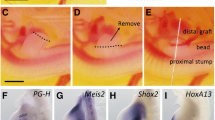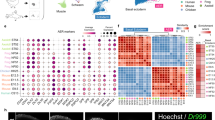Abstract
Many of the genes involved in the initial development of the limb in higher vertebrates are also expressed during regeneration of the limb in urodeles such as Notophthalmus viridescens. These similarities have led researchers to conclude that the regeneration process is a recapitulation of development, and that patterning of the regenerate mimics pattern formation in development. However, the developing limb and the regenerating limb do not look similar. In developing urodele forelimbs, digits appear sequentially as outgrowths from the limb palette. In regeneration, all the digits appear at once. In this work, we address the issue of whether regeneration and development are similar by examining growth and apoptosis patterns. In contrast to higher vertebrates, forelimb development in the newt, N. viridescens, does not use interdigital apoptosis as the method of digit separation. During adult forelimb regeneration, apoptosis seems to play an important role in wound healing and again during cartilage to bone turnover in the advanced digits and radius/ulna. However, similar to forelimb development, demarcation of the digits in adult forelimb regeneration does not involve interdigital apoptosis. Outgrowth, rather than regression of the interdigital mesenchyme, leads to the individualization of forelimb digits in both newt development and regeneration.







Similar content being viewed by others
References
Ballard KJ, Holt SJ (1968) Cytological and cytochemical studies on cell death and digestion in the foetal rat foot: the role of macrophages and hydrolytic enzymes. J Cell Sci 3:245–262
Brockes JP, Lo DC (1994) Reversibility of the mononucleate-to-multinucleate myogenic transition during amphibian limb regeneration. Eye 8:151–154
Butler EG (1933) The effects of x-radiation on the regeneration of the forelimb of Amblystoma larvae. J Exp Zool 65:271–315
Cadinouche MZ, Liversage RA, Muller W, Tsilfidis C (1999) Molecular cloning of the Notophthalmus viridescens radical fringe cDNA and characterization of its expression during forelimb development and adult forelimb regeneration. Dev Dynam 214:259–268
Cameron JA, Fallon JF (1977) The absence of cell death during development of free digits in amphibians. Dev Biol 55:331–338
Gardiner DM, Bryant SV (1996) Molecular mechanisms in the control of limb regeneration: the role of homeobox genes. Int J Dev Biol 40:797–805
Gavrieli Y, Sherman Y, Ben-Sasson SA (1992) Identification of programmed cell death in situ via specific labeling of nuclear DNA fragmentation. J Cell Biol 119:493–501
Gibson-Brown JJ, Agulnik SI, Chapman DL, Alexiou M, Garvey N, Silver LM, Papaioannou VE (1996) Evidence of a role for T-box genes in the evolution of limb morphogenesis and the specification of forelimb/hindlimb identity. Mech Dev 56:93–101
Gibson-Brown JJ, Agulnik SI, Silver LM, Niswander L, Papaioannou VE (1998) Involvement of T-box genes Tbx2-Tbx5 in vertebrate limb specification and development. Development 125:2499–2509
Hay ED (1959) Electron microscopic observations of muscle dedifferentiation in regenerating Amblystoma limbs. Dev Biol 1:555–585
Hickok NJ, Haas AR, Tuan RS (1998) Regulation of chondrocyte differentiation and maturation. Microsc Res Tech 43:174–190
Imokawa Y, Yoshizato K (1997) Expression of Sonic hedgehog gene in regenerating newt limb blastemas recapitulates that in developing limb buds. Proc Natl Acad Sci USA 94:9159–9164
Isaac A, Rodriguez-Esteban C, Ryan A, Altabef M, Tsukui T, Patel K, Tickle C, Izpisua-Belmonte JC (1998) Tbx genes and limb identity in chick embryo development. Development 125:1867–1875
Iten LE, Bryant SV (1973) Forelimb regeneration from different levels of amputation in the newt, Notophthalmus viridescens: length, rate and stages. Wilhelm Roux Arch 173:263–282
Jarvik E (1980) Basic structure and evolution of vertebrates. Academic, London
Jensen AM, Wallace VA (1997) Expression of Sonic hedgehog and its putative role as a precursor cell mitogen in the developing mouse retina. Development 124:363–371
Khan PA, Liversage RA (1995) Spawning of Notophthalmus viridescens and rearing of embryos under laboratory conditions. Herpetol Rev 26:95–96
Khan PA, Tsilfidis C, Liversage RA (1999) Hox C6 expression during development and regeneration of forelimbs in larval Notophthalmus viridescens. Dev Genes Evol 209:323–329
Khan P, Linkhart B, Simon HG (2002) Different regulation of T-box genes Tbx4 and Tbx5 during limb development and limb regeneration. Dev Biol 250:383–392
Logan M, Simon HG, Tabin C (1998) Differential regulation of T-box and homeobox transcription factors suggests roles in controlling chick limb-type identity. Development 125:2825–2835
Mescher AL, White GW, Brokaw JJ (2000) Apoptosis in regenerating and denervated, nonregenerating urodele forelimbs. Wound Repair Regen 8:110–116
Mori C, Nakamura N, Kimura S, Irie H, Takigawa T, Shiota K (1995) Programmed cell death in the interdigital tissue of the fetal mouse limb is apoptosis with DNA fragmentation. Anat Rec 242:103–110
Salas-Vidal E, Valencia C, Covarrubias L (2001) Differential tissue growth and patterns of cell death in mouse limb autopod morphogenesis. Dev Dynam 220:295–306
Sanders EJ, Wride MA (1995) Programmed cell death in development. Int Rev Cytol 163:105–173
Saunders JWJ (1966) Death in embryonic systems. Science 154:604–612
Savard P, Tremblay M (1995) Differential regulation of Hox C6 in the appendages of adult urodeles and anurans. J Mol Biol 249:879–889
Savard P, Gates PB, Brockes JP (1988) Position dependent expression of a homeobox gene transcript in relation to amphibian limb regeneration. EMBO J 7:4275–4282
Simon HG, Nelson C, Goff D, Laufer E, Morgan BA, Tabin C (1995) Differential expression of myogenic regulatory genes and Msx-1 during dedifferentiation and redifferentiation of regenerating amphibian limbs. Dev Dynam 202:1–12
Simon HG, Kittappa R, Khan PA, Tsilfidis C, Liversage RA, Oppenheimer S (1997) A novel family of T-box genes in urodele amphibian limb development and regeneration: candidate genes involved in vertebrate forelimb/hindlimb patterning. Development 124:1355–1366
Stock SR, Blackburn D, Gradassi M, Simon HG (2003) Bone formation during forelimb regeneration: a microtomography (microCT) analysis. Dev Dynam 226:410–417
Veenstra GJ, Peterson-Maduro J, Mathu MT, van der Vliet PC, Destree OH (1998) Non-cell autonomous induction of apoptosis and loss of posterior structures by activation domain-specific interactions of Oct-1 in the Xenopus embryo. Cell Death Differ 5:774–784
Zuzarte-Luis V, Hurle JM (2002) Programmed cell death in the developing limb. Int J Dev Biol 46:871–876
Acknowledgements
We thank Adam Baker for technical expertise, help with the figures, and critical reading of the manuscript. We thank Sandy Vascotto and Richard A. Liversage for helpful discussions. This work was supported by the Natural Sciences and Engineering Council of Canada (C.T.) and by the Canadian Institutes of Health Research (C.T.).
Author information
Authors and Affiliations
Corresponding author
Additional information
Edited by R.P. Elinson
Rights and permissions
About this article
Cite this article
Vlaskalin, T., Wong, C.J. & Tsilfidis, C. Growth and apoptosis during larval forelimb development and adult forelimb regeneration in the newt (Notophthalmus viridescens). Dev Genes Evol 214, 423–431 (2004). https://doi.org/10.1007/s00427-004-0417-1
Received:
Accepted:
Published:
Issue Date:
DOI: https://doi.org/10.1007/s00427-004-0417-1




